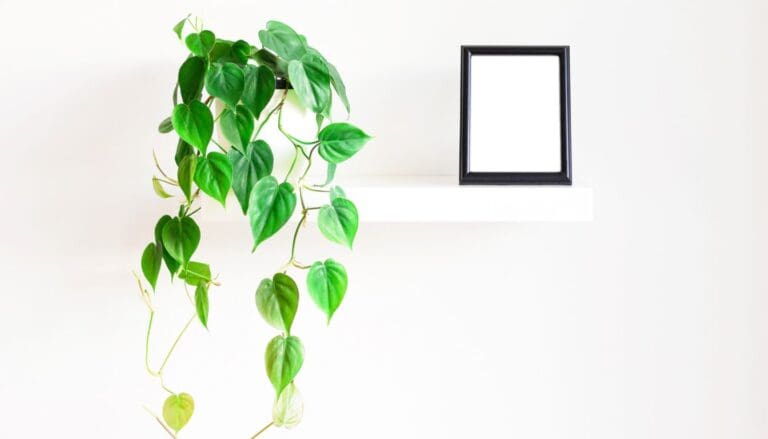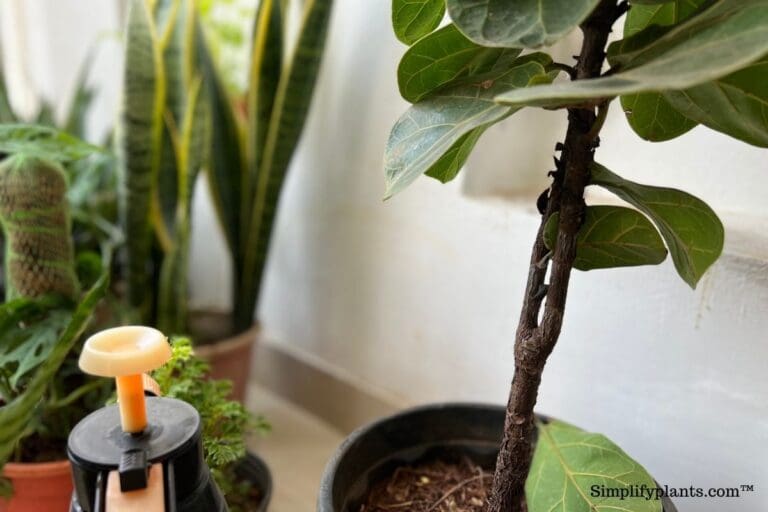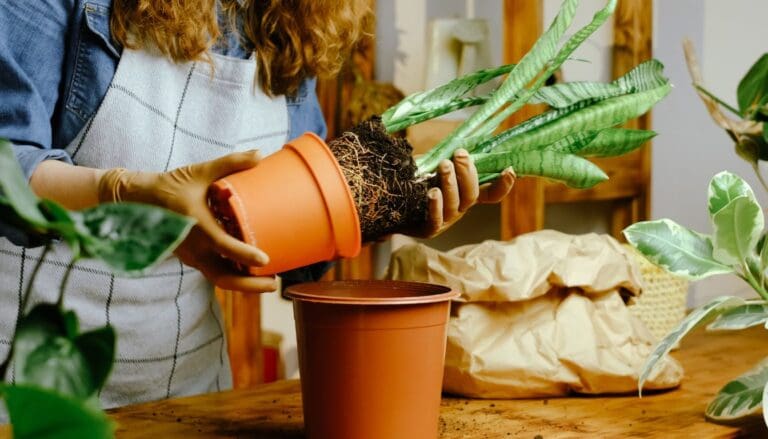What Type Of Pot Is Best For Arrowhead Plant? (Size, Material & More)
When we buy a new arrowhead plant from the market, we get them in plastic pots in a compost mix, making the plant survive until sold. Once you bring it home, it is important to repot it in a suitable pot.
Any clay-based or terracotta pot 1-2″ bigger than the previous pot will be ideal for the arrowhead plant. Choose the right size because a bigger pot can cause overwatering, while a small pot can make your Syngonium root-bound quickly. Also, ensure the pot has enough drainage holes.
This article will explain the importance of choosing the correct pot and help you find a suitable pot for your arrowhead plant.

Please note: Simplify Plants is reader-supported. Some links in the post are affiliate links and I get a commission from purchases made through links in the post.
How big of a pot does an arrowhead plant need?
Choosing the correct pot material for your arrowhead is important but choosing the correct size is equally important.
Many plant owners do not pay attention to these factors.
However, they do not know that these can affect the plant’s life.
The ideal pot will be one size bigger than the arrowhead and its roots.
If you are repotting, you should select a pot that is one size larger than the previous one.
But we will also look at the results of choosing a small and a big pot for your Syngonium.
Small pot
Using a pot that is too small for your arrowhead plant can cause trouble.
A pot that is too small can dry up the soil quickly, which can be good for succulents or cacti because they like dry soil, but for plants that require moisture in the soil, this can be a problem.
Moisture-loving plants will face underwatering if planted in a too-small pot.
A smaller pot would also make the plant rootbound quicker and need repotting.
This would affect the growth of your arrowhead plant as the roots of these plants are expansive and need enough space to spread and grow.
Planting the Syngonium in a smaller pot will suffocate the roots.
Extremely small pots can also make the plant look top-heavy, which might risk toppling over, making the floor messy and dirty.
Large pot
A large plant will require a large pot.
The size of the plant and the pot should be proportionate to one another.
Plants that have grown large and tall should be grown in larger pots to avoid toppling over.
However, you must keep a few points in mind.
If you plant your Syngonium in a larger pot, it will have the risk of overwatering.
The excess water stays in the soil longer, leading to root rot and overwatering.
Therefore, use a 1-2″ bigger pot than the existing pot size of the arrowhead.
What type of pot is used for Syngonium?
There are many varieties of pots available in the market.
Depending on the type, moisture preference, and size, you must select a pot that would be best for your Syngonium.
Let’s look at all the different pot materials available in the market.
Terracotta pot
These are clay-based pots and are widely used for indoor and outdoor plants.
I recommend using a terracotta pot for your Syngonium if you want its roots to stay well-aerated and healthy.
Pros:
- The earthy texture of the terracotta pot will suit your Syngonium.
- Terracotta pots come in various sizes that can accommodate tiny succulents to large plants.
- Terracotta is the least costly of all pot types.
- Terracotta pots wick away the excess moisture, so ideal for arrowhead plants as they don’t need excess moisture.
- The chances of pests and infections are lowest in terracotta pots as they don’t let the soil stay soggy unless you overwater.
- Terracotta pots are heavy and stable and don’t fall over easily.
Cons:
- Terracotta pots are brittle, and there is a high risk of crack or damage if the pot falls.
- Since terracotta pots are porous, the soil tends to dry out quickly, so you need to water your arrowhead more frequently.
- Terracotta pots are quite heavy, making it difficult to move the potted plant from one location to another.
Ceramic pot
Ceramic pots are in demand due to their elegant visual appeal, and houseplant owners like to plant their arrowheads in ceramic pots to increase their beauty.
They are less porous than terracotta pots.
Pros:
- Ceramic pots are available in different shapes, colors, and designs, making them extremely decorative for arrowhead plants.
- The soil does not dry as quickly since ceramic pots are not as porous as terracotta pots.
- Ceramic pots are ideal for moisture-loving plants.
- Ceramic pots are heavy and stable, like terracotta pots.
- Though still breakable, ceramic pots are more durable than terracotta pots and last long.
Cons:
- Ceramic pots can be quite heavy, making them difficult to move around.
- The fancy ceramic pots can be quite expensive.
- One major problem with ceramic pots is that most of them don’t come with drainage holes, so excess water from the plants doesn’t get a chance to flow out. They stay inside the pot leading to diseases. You must drill holes at the bottom of these pots if you want to avoid making the soil soggy or causing overwatering.
Plastic pot
Plastic pots have become quite popular in the houseplant community, and although you can use it for your Syngonium, you need to be careful as the hazards can be deadly for your plant.
Pros
- Among all the different types of planters, plastic pots are the cheapest.
- One advantage of using plastic pot over all other pot types is that it is lightweight and can be carried around the house.
- Another big advantage of plastic pots is that they will not break or get damaged easily.
- Plastic pots are available in various colors, shapes, and sizes.
- The moisture in the soil remains for a long time, so it is suitable for plants that like moisture.
Cons
- One major drawback of plastic pots is that the colors fade when kept in the scorching sun.
- Plastic pots are non-porous, so excess moisture does not evaporate, and the soil stays soggy for too long. This can lead to diseases and fungus growth if you don’t check the watering.
Wooden pot
Wooden pots are natural and give a rich look.
If made from good quality wood, they can last for years.
Sometimes they are also lined with plastic to prevent water damage to the wood.
They are more commonly seen in outdoor gardens than indoor.
Pros:
- Wooden pots are an easy DIY option, and you can get customized size and design as per your choice.
- You can paint these pots with colors of your choice.
- They cost lower than ceramics or high-end terracotta pots.
- You can recycle old wooden boxes, crates, or baskets as this reduces waste and are environmentally friendly.
Cons:
- Wooden pots require periodic maintenance, which might be troublesome for some.
- Wooden pots might leak, so a tray at the bottom is necessary for a clean place.
- After a few years, the wood starts to decay if there is no plastic lining inside the wood as it constantly remains wet and soggy.
Metal pot
Metal pots bring a unique, sophisticated touch to indoor gardens.
Pros:
- Metal pots can be durable and long-lasting.
- If you already have a metal container, you can use it as a pot for your arrowhead as long as you are willing to drill a hole under it.
- Along with being plant pots, they act as decorative pieces giving your indoor area a classy look.
- Metal pots are available in multiple sizes and styles.
Cons:
- Large metal pots can become heavy, especially after putting your Syngonium inside it with the soil.
- Metal pots might not come with drainage holes, so you need to drill some before planting your arrowhead in them.
- One major problem with metal pots is that they rust with time.
- Metals get heated fast if left in direct sunlight, making the soil hot and dry quickly.
- Metal is not porous, which can keep the soil soggy and moist for a long time, leading to fungus and root rot in your arrowhead.
Fiberglass pot
These are new in the gardening industry and have quickly become a favorite for houseplant owners due to their several advantages.
Fiberglass pots can be made in different shapes and sizes and are often mistaken for ceramic or plastic pots.
Pros:
- Fiberglass pots are super durable.
- Fiberglass pots are available in a large variety of sizes and shapes.
- They are way more lightweight than clay or ceramic pots, so they are easy to move around the house.
- They are non-porous and hold moisture for long, suitable for moisture-loving plants.
Cons:
- Fiberglass pots are quite expensive compared to terracotta or plastic pots.
- After using this pot for a long time, the outside lining of the pot can become dull.
- They are not as sturdy as plastic pots.
You can use any potting material for your arrowhead plant as long as you know how to care for it.
The same plant might require different care in different pot materials.
But I would recommend selecting the terracotta pot or any clay-based pot for your Syngonium as it would suit all the plant’s needs.
Importance of drainage
Good drainage is extremely important for arrowhead plants as they like don’t enjoy sitting in soggy soil.
If your arrowhead plant sits in water for too long, the roots will become unhealthy and decay.
Therefore, while choosing a pot for your Syngonium, you can’t miss the drainage holes.
Drainage holes allow the excess water to drain out of the pot and help the soil dry up faster.
Without drainage holes:
- The soil will remain wet, giving rise to diseases and pest infestations.
- The excess water will block the oxygen flow into the roots.
- Your arrowhead plant can develop the root rot disease that can lead to its death.
- Fertilizers will build upon the soil as they will not get a chance to flush out of the system.
If you want to avoid all the above problems, you must get a pot with drainage holes.
Even if the pot doesn’t have drainage holes, you can drill them with a drilling machine before planting your arrowhead inside it.
Avoid using a pot without drainage holes.
Should I use a cachepot for my arrowhead plant?
Cachepots are decorative pots that don’t have drainage holes.
Many plant-owners like to use fancy pots for their houseplants as these increase the visual interest of the space.
But you already read the effects of no drainage holes in pots for your arrowhead plants.
If you want to use a cachepot for your Syngonium, you can put the clay or plastic pot that you are already using inside the cachepot.
But, you must remember to empty the cache pot as the plant will get overwatered otherwise.
An even better alternative would be to take the Syngonium out of the cachepot, water it, let the excess water drain out, and put it back again.
Basic tips for planting arrowhead plants in pots
- Use pots that are not more than 2 inches bigger than their existing pot.
- Avoid planting the arrowhead too deep into the soil, which might cause undue stress on the plant.
- Use a potting mix that is fertile and well-draining not to make the soil heavy and soggy. A mixture of regular potting soil, coco coir, and perlite is ideal for Syngonium.
Final words
Arrowhead plants are easy to grow climbing houseplants that require low maintenance, but if you don’t choose the correct sized pot, the plant can develop various issues.
You must choose a pot that is one size larger than the roots and size of your arrowhead plant. If you are repotting it, use a 1-2″ bigger pot than the previous one.
Other than the size, you must also choose the correct material and ensure that the pot has drainage holes to avoid overwatering issues.
The right pot and knowledge of taking care of arrowhead plants will help the plant thrive and remain healthy without developing any issues.
Reference: CABI, Britannica, United States Department of Agriculture, Wikipedia, Children’s Health Queensland Hospital and Health Service, Missouri Botanical Garden.
Recommended Garden Supplies
| Product Image | Our Recommended Gardening Supplies | Check Offers! |
|---|---|---|
Top Top
Top
Top
Top
Top
Top
Top
Top | rePotme Houseplant and Tropical Classic Potting Soil Mix | Check Offer On Amazon |
 Top
Top
Top
Top
Top
Top
Top
Top | Espoma Organic Indoor Plant Food | Check Offer On Amazon |
 Top
Top
Top
Top
Top
Top
Top
Top | GooingTop LED Grow Light 6000K Full Spectrum Clip Plant Growing Lamp | Check Offer On Amazon |
 Top
Top
Top
Top
Top
Top
Top
Top | Soil Moisture Meter | Check Offer On Amazon |
 Top
Top
Top
Top
Top
Top
Top
Top | Govee Hygrometer Thermometer, Bluetooth Enabled! | Check Offer On Amazon |
 Top
Top | LEVOIT Humidifiers for Large Room(Best For Plants) | Check Offer On Amazon |
 Top
Top
Top
Top
Top
Top
Top
Top | Upgraded DIY Automatic Drip Irrigation Kit, 15 Potted Houseplants Support | Check Offer On Amazon |
 Top
Top
Top
Top
Top
Top
Top
Top | Stainless Steel Heavy Duty Gardening Tool Set | Check Offer On Amazon |
 Top
Top
Top
Top
Top
Top
Top
Top | Bonide Insecticidal Soap | Check Offer On Amazon |
 Top
Top
Top
Top
Top
Top
Top
Top | Bonide 32 oz Spray Neem Oil for Organic Gardening | Check Offer On Amazon |
 Top
Top
Top
Top
Top
Top
Top
Top | Garden Safe Fungicide | Check Offer On Amazon |











